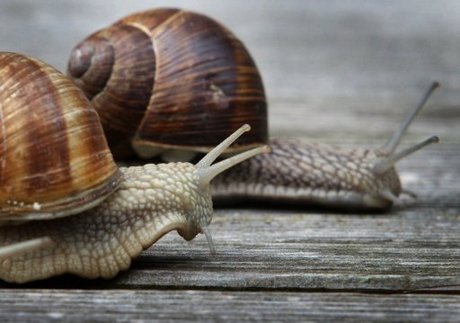Ancient Snail Relative Found

Fossils of toothy, slug-like creatures that grazed the sea floor 500 million years ago have shed light on the origins of modern-day snails, shellfish and squid, a study said Wednesday.
The most comprehensive analysis yet of the ancient slugs' mouth parts -- multiple rows of teeth that moved in conveyor-belt fashion, showed they were related to present day molluscs, scientists wrote in the journal Proceedings of the Royal Society B.
Dubbed Wiwaxia and Odontogriphus, the slugs' place on the evolution ladder has been in contention for decades -- whether they were early molluscs, relatives of the earthworm, or a completely different species that died out.
Using new microscope technology, Martin Smith, a graduate student at the University of Toronto's department of evolutionary biology, found they shared a feeding mechanism with today's molluscs.
"Their mouthparts are... the closest thing that we have to the radula, the conveyor-belt-like feeding apparatus found in almost all molluscs today," he told Agence France Presse.
"My new reinterpretation of their 'teeth' shows that they represented early molluscs."
Molluscs, which also include octopuses, mussels and oysters, are the second-biggest animal group, yet little has been known about their early evolution.
Odontogriphus, whose name means "toothed riddle" in Greek, was a naked slug that grew up to 15 centimeters (six inches) long, while tiny Wiwaxia, between 1 millimeter and 5 cm, was covered with spines and scales.
The invertebrate fossils come from the Burgess Shale Formation in the Canadian province of British Columbia, deposited there during the Middle Cambrian period about 505 million years ago.
To study the remains, Smith used an electron microscope which has a resolution about a thousand times better than that of a light microscope, "so you see loads more detail" of the mouth parts.
It has only recently become possible to put large fossils in electron microscopes without damaging them.
The researcher concluded that the mouths of Wiwaxia and Odontogriphus had two to three rows of 17-33 teeth of a similar size, with a symmetrical central tooth and more, smaller teeth on the edges.
The teeth would have moved around a tongue in the same way as those of both plant- and meat-eating molluscs today, scooping algae and organic waste from a muddy sea floor.
"I don't see how you can doubt that they are molluscs anymore," said Smith.
What is not clear is whether these fossils were the direct ancestors of today's molluscs.
There were likely several similar-looking species living alongside Wiwaxia and Odontogriphus, but since species cannot interbreed, only one could have given rise to the snails and slugs we know today.
"It's possible that Odontogriphus or Wiwaxia was this species, but it's more likely that they were very close relatives -- offshoots from the lineage that would have led to all molluscs," said Smith.



